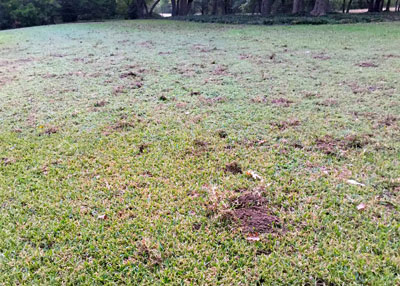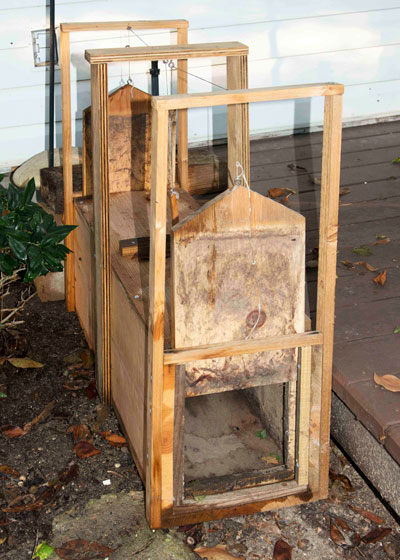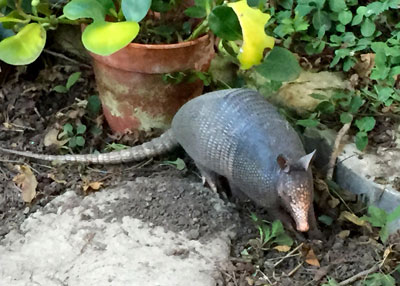Question of the Week Number 2: October 12, 2017
“Neil, how can I get rid of armadillos? They are ruining our yard.”

Photo: One or two armadillos can do this much damage to a lawn in just a couple of hours.
Perhaps no animal is any more damaging to Texas lawns, landscapes and gardens than armadillos. They plow through our plantings, often for seemingly no apparent reason. And the question becomes, how can we eliminate them before they do any more harm?
Before I go any farther, there are many who will say that armadillos are feeding on grub worms, and that may be the case, but I can tell you that I don’t have enough grub worms in my own lawn to keep even a baby armadillo alive, so treating for grubs isn’t going to be much of a help. So let’s move on to something that I’ve found to work.
I have lived this nightmare first-hand. We live in a rural area, in a pecan forest if you will. Wildlife abounds. Armadillos included. That photo of the torn-up turf is our hillside up toward the county road.
Some 35 or more years ago a gentleman brought me a wooden trap he had crafted for the humane capture of armadillos. He gave me instructions on how to place and bait it, and to our surprise, it really worked. Within a month we had caught several of the varmints. Our totals now, from that original trap and its replacements, are up past 80. We caught a mother and six of her babies in a two-day period last spring.

Photo: You can see the trap and how it works from this set up adjacent to my “Santa barn” workshop. We have caught several coming in and out here.
Steps to the capture…
Here’s what we do when we begin to see their damage showing up.
• Look for their burrows. Armadillos always have tunnels, usually fairly well hidden. Often they’ll have more than one. I’ve found them beneath our deck, beneath the foundation (hidden by shrubs), under a retaining wall, beside a large landscaping boulder and in the top edge of a dry creek bank. And those are just the ones that I’ve found. I know there are others.
• If you see an armadillo out in your landscape in the evening, chase it away. See where it goes. That will probably show you where its favored burrow is located.

Photo: I saw this armadillo in among my containers. It’s an iPhone photo taken in haste, but we quickly got the trap set in place.
• Place your trap in the most direct path to that burrow.
• Construct a temporary fence out of 18-inch chicken wire. It should extend out from the trap by 10 or 15 feet on either side. They will create a sort of funnel. The armadillo will encounter the wire, scurry along it and then try to pass through the opening (trap).

Photo: By the next morning, we had an armadillo captured and ready for dispatch. You’d be amazed at how heavy they are.
• Set the trap so that the armadillo will knock the trigger loose and cause the doors to drop.
• The man suggested we use raw bacon to bait our trap, but we found that we really didn’t need that. Not using bait reduced the chance of capturing small dogs. Oh, we’ve opened our doors a couple of times to find a smiling o’possum inside, but otherwise, it’s been pretty much all armadillos.
• If you’re going to catch an armadillo in a particular spot you probably will do so within three or four days. If you don’t, it’s probably time to find another location. Be sure, too, that rainfall and sprinklers don’t cause the wood to swell.
• Check your trap each morning. Don’t leave the armadillo inside on hot, sunny days. You need to dispose of it punctually.
• Farm supply stores sell metal humane traps that also might work. Choose one that’s sized for a raccoon.
At this point I need to step aside long enough to say that I’m not much of a hunter. As much as I dislike armadillos, I just don’t kill things. We have the benefit of a Corps of Engineers lake nearby, and I release them at a spot that’s several miles from our house and any other houses as well. I know that makes no sense to many of you, but I have to live with myself, and it’s my solution to the dilemma.
Armadillos will soon go into hibernation for the winter, but maybe this will give you hope of eliminating them soon. If not this fall, by early next spring.
